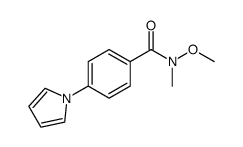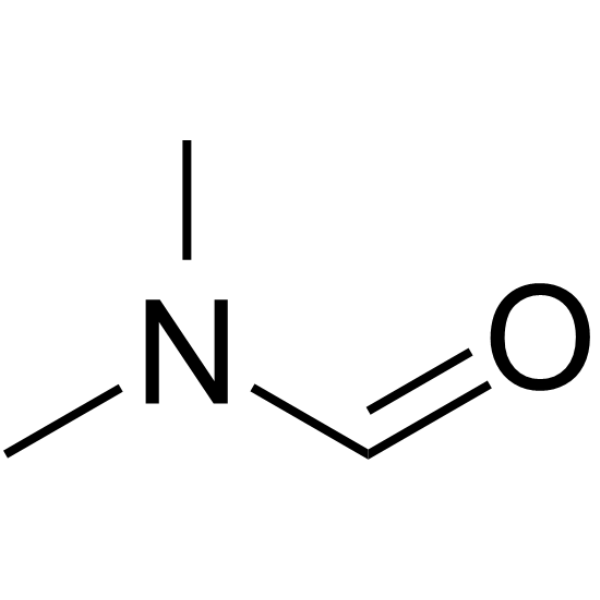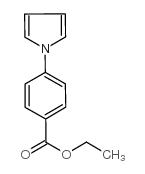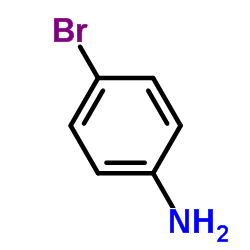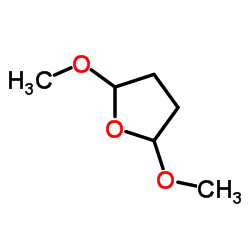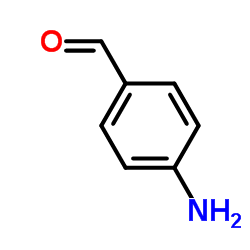4-(1H-Pyrrol-1-yl)benzaldehyde
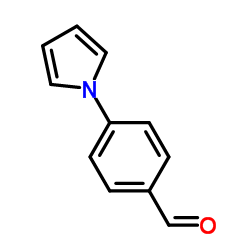
4-(1H-Pyrrol-1-yl)benzaldehyde structure
|
Common Name | 4-(1H-Pyrrol-1-yl)benzaldehyde | ||
|---|---|---|---|---|
| CAS Number | 23351-05-5 | Molecular Weight | 171.195 | |
| Density | 1.1±0.1 g/cm3 | Boiling Point | 306.7±25.0 °C at 760 mmHg | |
| Molecular Formula | C11H9NO | Melting Point | 94-95ºC | |
| MSDS | N/A | Flash Point | 139.3±23.2 °C | |
| Name | 4-pyrrol-1-ylbenzaldehyde |
|---|---|
| Synonym | More Synonyms |
| Density | 1.1±0.1 g/cm3 |
|---|---|
| Boiling Point | 306.7±25.0 °C at 760 mmHg |
| Melting Point | 94-95ºC |
| Molecular Formula | C11H9NO |
| Molecular Weight | 171.195 |
| Flash Point | 139.3±23.2 °C |
| Exact Mass | 171.068420 |
| PSA | 22.00000 |
| LogP | 2.50 |
| Vapour Pressure | 0.0±0.6 mmHg at 25°C |
| Index of Refraction | 1.573 |
Synonym: Section 2 - COMPOSITION, INFORMATION ON INGREDIENTS
Risk Phrases: None Listed. Section 3 - HAZARDS IDENTIFICATION EMERGENCY OVERVIEW
Not available. Potential Health Effects Eye: May cause eye irritation. Skin: May cause skin irritation. May be harmful if absorbed through the skin. Ingestion: May cause irritation of the digestive tract. May be harmful if swallowed. Inhalation: May cause respiratory tract irritation. May be harmful if inhaled. Chronic: Not available. Section 4 - FIRST AID MEASURES Eyes: Flush eyes with plenty of water for at least 15 minutes, occasionally lifting the upper and lower eyelids. Get medical aid. Skin: Get medical aid. Flush skin with plenty of water for at least 15 minutes while removing contaminated clothing and shoes. Ingestion: Get medical aid. Wash mouth out with water. Inhalation: Remove from exposure and move to fresh air immediately. Notes to Physician: Treat symptomatically and supportively. Section 5 - FIRE FIGHTING MEASURES General Information: As in any fire, wear a self-contained breathing apparatus in pressure-demand, MSHA/NIOSH (approved or equivalent), and full protective gear. Extinguishing Media: Use water spray, dry chemical, carbon dioxide, or chemical foam. Section 6 - ACCIDENTAL RELEASE MEASURES General Information: Use proper personal protective equipment as indicated in Section 8. Spills/Leaks: Vacuum or sweep up material and place into a suitable disposal container. Section 7 - HANDLING and STORAGE Handling: Avoid breathing dust, vapor, mist, or gas. Avoid contact with skin and eyes. Storage: Store in a cool, dry place. Store in a tightly closed container. Store under an inert atmosphere. Section 8 - EXPOSURE CONTROLS, PERSONAL PROTECTION Engineering Controls: Use adequate ventilation to keep airborne concentrations low. Exposure Limits CAS# 23351-05-5: Personal Protective Equipment Eyes: Not available. Skin: Wear appropriate protective gloves to prevent skin exposure. Clothing: Wear appropriate protective clothing to prevent skin exposure. Respirators: Follow the OSHA respirator regulations found in 29 CFR 1910.134 or European Standard EN 149. Use a NIOSH/MSHA or European Standard EN 149 approved respirator if exposure limits are exceeded or if irritation or other symptoms are experienced. Section 9 - PHYSICAL AND CHEMICAL PROPERTIES Physical State: Solid Color: yellow Odor: Not available. pH: Not available. Vapor Pressure: Not available. Viscosity: Not available. Boiling Point: Not available. Freezing/Melting Point: 94 - 95 deg C Autoignition Temperature: Not available. Flash Point: Not available. Explosion Limits, lower: Not available. Explosion Limits, upper: Not available. Decomposition Temperature: Solubility in water: Specific Gravity/Density: Molecular Formula: C11H9NO Molecular Weight: 171.2 Section 10 - STABILITY AND REACTIVITY Chemical Stability: Not available. Conditions to Avoid: Incompatible materials. Incompatibilities with Other Materials: Strong oxidizing agents. Hazardous Decomposition Products: Nitrogen oxides, carbon monoxide, carbon dioxide. Hazardous Polymerization: Has not been reported Section 11 - TOXICOLOGICAL INFORMATION RTECS#: CAS# 23351-05-5 unlisted. LD50/LC50: Not available. Carcinogenicity: 4-(1H-Pyrrol-1-yl)benzaldehyde - Not listed by ACGIH, IARC, or NTP. Section 12 - ECOLOGICAL INFORMATION Section 13 - DISPOSAL CONSIDERATIONS Dispose of in a manner consistent with federal, state, and local regulations. Section 14 - TRANSPORT INFORMATION IATA No information available. IMO No information available. RID/ADR No information available. Section 15 - REGULATORY INFORMATION European/International Regulations European Labeling in Accordance with EC Directives Hazard Symbols: Not available. Risk Phrases: Safety Phrases: S 24/25 Avoid contact with skin and eyes. WGK (Water Danger/Protection) CAS# 23351-05-5: No information available. Canada None of the chemicals in this product are listed on the DSL/NDSL list. CAS# 23351-05-5 is not listed on Canada's Ingredient Disclosure List. US FEDERAL TSCA CAS# 23351-05-5 is not listed on the TSCA inventory. It is for research and development use only. SECTION 16 - ADDITIONAL INFORMATION N/A |
|
~99% 
4-(1H-Pyrrol-1-... CAS#:23351-05-5 |
| Literature: Tanaka, Akira; Terasawa, Takeshi; Hagihara, Hiroyuki; Sakuma, Yuri; Ishibe, Noriko; Sawada, Masae; Takasugi, Hisashi; Tanaka, Hirokazu Journal of Medicinal Chemistry, 1998 , vol. 41, # 13 p. 2390 - 2410 |
|
~84% 
4-(1H-Pyrrol-1-... CAS#:23351-05-5 |
| Literature: Artico; Silvestri; Stefancich; Avigliano; Di Giulio; Maccarrone; Agostinelli; Mondovi; Morpurgo European Journal of Medicinal Chemistry, 1992 , vol. 27, # 3 p. 219 - 228 |
|
~77% 
4-(1H-Pyrrol-1-... CAS#:23351-05-5 |
| Literature: Nakazaki, Jotaro; Chung, InGwon; Matsushita, Michio M.; Sugawara, Tadashi; Watanabe, Ryoji; Izuoka, Akira; Kawada, Yuzo Journal of Materials Chemistry, 2003 , vol. 13, # 5 p. 1011 - 1022 |
|
~% 
4-(1H-Pyrrol-1-... CAS#:23351-05-5 |
| Literature: Journal of Medicinal Chemistry, , vol. 41, # 13 p. 2390 - 2410 |
|
~% 
4-(1H-Pyrrol-1-... CAS#:23351-05-5 |
| Literature: European Journal of Medicinal Chemistry, , vol. 27, # 3 p. 219 - 228 |
|
~% 
4-(1H-Pyrrol-1-... CAS#:23351-05-5 |
| Literature: Journal of Materials Chemistry, , vol. 13, # 5 p. 1011 - 1022 |
|
~% 
4-(1H-Pyrrol-1-... CAS#:23351-05-5 |
| Literature: Synthesis, , # 6 art. no. M06008SS, p. 980 - 984 |
| HS Code | 2933990090 |
|---|---|
| Summary | 2933990090. heterocyclic compounds with nitrogen hetero-atom(s) only. VAT:17.0%. Tax rebate rate:13.0%. . MFN tariff:6.5%. General tariff:20.0% |
| 4-(1-pyrrolyl)benzaldehyde |
| 4-pyrrolylbenzaldehyde |
| Benzaldehyde, 4-(1H-pyrrol-1-yl)- |
| 1-(4'-formylphenyl)pyrrole |
| 4-(1-pyrrol)benzaldehyde |
| 4-(1H-Pyrrol-1-yl)benzaldehyde |
| 4-Pyrrol-1-yl-benzaldehyde |
